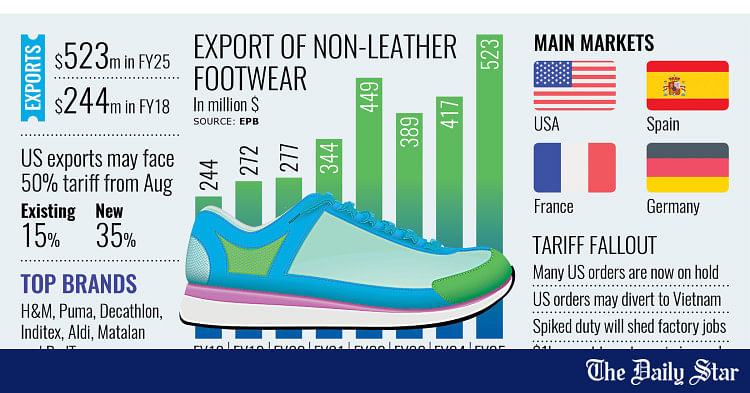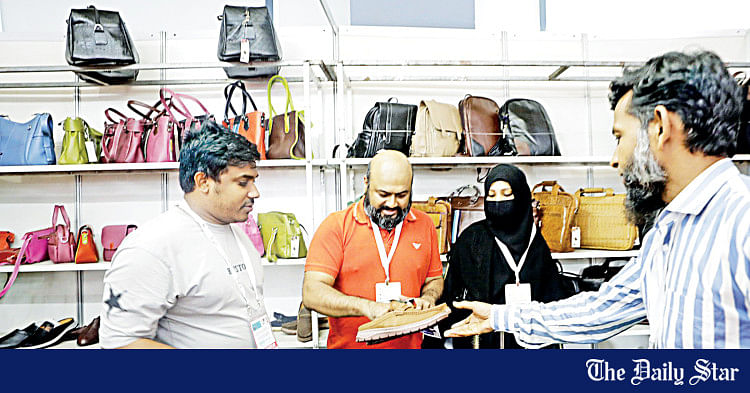- Joined
- Jan 24, 2024
- Messages
- 3,625
- Questions Answered
- 1
- Reaction score
- 1,879
Here is a factory overview for Shoeniverse Ltd. in Mymensingh






I think the tariff threats are a bargaining tool by the US Trade office.
US tariff threatens booming synthetic shoe exports
The country’s growing non-leather footwear industry now faces a major setback as a steep new tariff from the United States threatens its growthwww.thedailystar.net
US tariff threatens booming synthetic shoe exports
View attachment 20211
The country's growing non-leather footwear industry, which more than doubled its exports in just seven years, now faces a major setback as a steep new tariff from the United States threatens its growth and global competitiveness.
Synthetic shoes, popular worldwide for their comfort and style over leather footwear, helped push export earnings from this segment to $523 million in the recently concluded fiscal year (FY) 2024-25, up from $244 million in FY 2017-18.
Buoyed by increasing global demand, manufacturers had been eyeing $1 billion in annual earnings within the next two to three years.
But that optimism is now fading as Bangladeshi exporters will have to contend with a 50 percent tariff on synthetic footwear shipments to the US from August 1.
The rate includes a newly imposed 35 percent duty on top of the 15 percent they were already paying.
Local shoe-makers fear this could reverse a trend that had seen US buyers increasingly shifting their sourcing from China to Bangladesh. The move is likely to hand the advantage to Vietnam, which faces a much lower 20 percent tariff.
"This sector thrives because global buyers see Bangladesh as a cost-effective alternative to China," said Riad Mahmud, managing director of Shoeniverse Footwear.
"But a 35 percent additional tariff would erase our price advantage and push buyers towards Vietnam, which has to pay a tariff of only 20 percent," he added.
Mahmud said that the sharp rise in duty could wipe out profits, disrupt cash flow, and threaten jobs.
His Shoeniverse plant in Mymensingh alone employs 4,700 workers.
He said, "Around 95 percent of orders from US buyers have been temporarily postponed due to the new tariff. This is not an industry where you can pause for six weeks and simply restart."
Over the years, Bangladesh has been gaining traction in the global synthetic shoe market, thanks to its competitive labour costs and export experience from the readymade garments sector.
The country's Western buyers include leading brands like H&M, Puma, Decathlon, Inditex, Aldi, Matalan, and RedTape. After the pandemic, these brands have been placing more orders to diversify away from China.
According to the Bangladesh Investment Development Authority (Bida), the non-leather segment is rapidly catching up with leather footwear, which earned $672 million in exports in FY 2024-25, a 23.54 percent increase year-on-year.
But while synthetic shoes are cheaper to make, the profit margins are razor-thin.
Mahmud mentioned that labour makes up 20 to 22 percent of production costs, while raw materials account for around 70 percent. On top of that, delays at customs and unclear trade policies are putting further pressure on the sector.
"Without clarity, planning is impossible. Bangladesh has the skills to lead in synthetic footwear, but we urgently need stable trade conditions," said Mahmud.
Hasnat Md Abu Obida Marshall, managing director of Maf Shoes Ltd, which supplies footwear items to brands like Kappa and H&M, said many exporters were already feeling the heat, with US orders either on hold or cancelled.
"European buyers have not objected yet, but those in the US market could suffer badly," he said.
Marshall said the new tariff imposed by the Trump administration adds to long-standing issues.
Unlike China, Bangladesh depends heavily on imported raw materials, often taxed at up to 60 percent, which raises product costs eventually.
"We import everything yet try to compete on price," said Marshall, adding that China not only has local access to raw materials but also offers 7 to 12 percent government incentives.
According to him, even an 8 percent cash incentive offered by Bangladesh fails to make a meaningful impact.
"If I pay 60 percent duty and get 8 percent incentive, there is no real benefit left," Marshall said, adding that many exporters skip the incentive altogether due to the bureaucratic process.
He also identified low productivity as a concern, saying that despite lower wages than in Vietnam, Bangladesh still falls behind in producing value-added footwear.
The shoe-maker also said that the country's graduation from the least-developed country club in November next year further clouds the sector's outlook.
"If we rush into investments, we risk heavy losses and job cuts," he said.
The tariff uncertainty has already rippled into other sectors like garments, he added, and could damage Bangladesh's standing in the global footwear market without strong policy support and investment in capacity.
Ahsan Khan Chowdhury, chairman and CEO of Pran-RFL Group, said the new US tariff would severely disrupt exports to the American market, especially for companies that had made targeted investments there.
He urged the government to expedite negotiations with US authorities to secure continued access and protect the export sector.
"If Bangladeshi exporters fail to remain competitive in the US market, they will have to seek alternative destinations to recover their investments and safeguard the jobs of hundreds of workers," Chowdhury said.
Hasanuzzaman, managing director and CEO of BLING Shoes Ltd, which posted 30 percent export growth last fiscal year, echoed similar concerns.
Hasanuzzaman said he supplies US buyers, including Merrell, Saucony, and Carter, and although none of his current orders have been cancelled, the future is uncertain.
"If the tariff is not reduced, exports will definitely be hampered," he said.


US trade representatives have already sent a long list of products on which they need Bangladesh to give duty free access.I think the tariff threats are a bargaining tool by the US Trade office.
Trade reps from Bangladesh are already negotiating actively with US trade reps and there will be agreements reached soon...
US trade representatives have already sent a long list of products on which they need Bangladesh to give duty free access.



 www.newagebd.net
www.newagebd.net





































